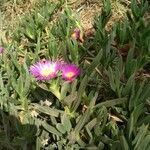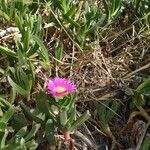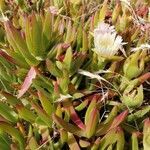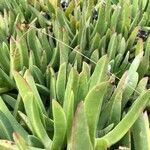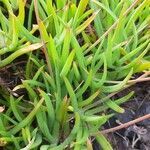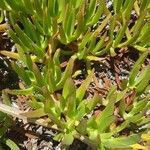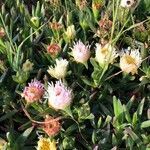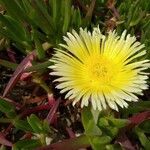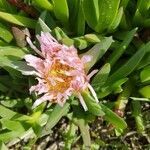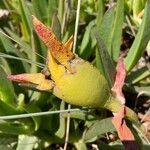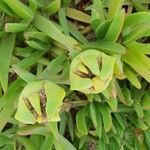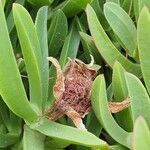Mat-forming trailing perennial herb. Stems to 6 m long, glabrous, 2-angled, subwoody at base. Lvs smooth, sharply 3-angled, linear, acute, scarcely tapered to connate base, 70-120 × 12-17 mm, 4-7× as long as wide; keel denticulate, at least near apex. Fls 8-10 cm diam. Calyx glabrous; longest sepals 40-55 mm long. Petals spreading, pale yellow, turning pinkish orange with age, 30-40 mm long. Stamens c. 10 mm long; filaments yellow, hairy at base; anthers yellow. Stigmas (8)-10-12. Seeds brown, obovoid, 1-1.3 mm long.
A succulent small shrub. It is a creeper. It grows 10-15 cm high and spreads 100-150 cm wide. The branches are long and have 2 edges. They branch extensively. They lie along the ground. The leaves are flattened and fleshy. They are 11 cm long. They are 3 angled and bent. The flowers are 9-12 cm across. They are light yellow or pink and occur singly. The fruit are shaped like a top. They have a red tint. They are edible.
Succulent shrub, with trailing robust stems, up to ± 2 m long and winged, 10-15 mm thick internodes. Leaves 3-angled, straight or slightly curved, (40-)50-120(-140) mm long, 7-20 mm thick, dull or pale green. Flowers pedicellate, solitary, 70-90 mm diam., yellow, turning pink when aging. Fruit 7-14-locular, fleshy, an indehiscent berry.
Receptacle top-shaped, tapering into pedicel. Succulent perennial with trailing stems to 2 m long. Leaves straight or slightly curved. Flowers yellow, fading to pink with age, stigmas ± as long as stamens, receptacle top-shaped, tapering into pedicel. Fruits clavate to subglobose, yellowish.
